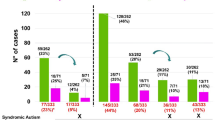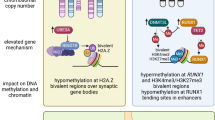Abstract
Autism and mental retardation (MR) show high rates of comorbidity and potentially share genetic risk factors. In this study, a rare ∼2 Mb microdeletion involving chromosome band 15q13.3 was detected in a multiplex autism family. This genomic loss lies between distal break points of the Prader–Willi/Angelman syndrome locus and was first described in association with MR and epilepsy. Together with recent studies that have also implicated this genomic imbalance in schizophrenia, our data indicate that this CNV shows considerable phenotypic variability. Further studies should aim to characterise the precise phenotypic range of this CNV and may lead to the discovery of genetic or environmental modifiers.
Similar content being viewed by others
Log in or create a free account to read this content
Gain free access to this article, as well as selected content from this journal and more on nature.com
or
References
Bailey A, Le Couteur A, Gottesman I et al: Autism as a strongly genetic disorder: evidence from a British twin study. Psychol Med 1995; 25: 63–77.
Steyaert JG, De La Marche W : What's new in autism? Eur J Pediatr 2008; 167: 1091–1101.
Sykes NH, Lamb JA : Autism: the quest for the genes. Expert Rev Mol Med 2007; 9: 1–15.
Baker P, Piven J, Schwartz S, Patil S : Brief report: duplication of chromosome 15q11-13 in two individuals with autistic disorder. J Autism Dev Disord 1994; 24: 529–535.
Cook Jr EH, Lindgren V, Leventhal BL et al: Autism or atypical autism in maternally but not paternally derived proximal 15q duplication. Am J Hum Genet 1997; 60: 928–934.
Marshall CR, Noor A, Vincent JB et al: Structural variation of chromosomes in autism spectrum disorder. Am J Hum Genet 2008; 82: 477–488.
Weiss LA, Shen Y, Korn JM et al: Association between microdeletion and microduplication at 16p11.2 and autism. N Engl J Med 2008; 358: 667–675.
Sharp AJ, Mefford HC, Li K et al: A recurrent 15q13.3 microdeletion syndrome associated with mental retardation and seizures. Nat Genet 2008; 40: 322–328.
Fombonne E : The changing epidemiology of autism. J Appl Res Intellect Disabil 2005; 18: 281–294.
Clifford S, Dissanayake C, Bui QM, Huggins R, Taylor AK, Loesch DZ : Autism spectrum phenotype in males and females with fragile X full mutation and premutation. J Autism Dev Disord 2007; 37: 738–747.
Ghebranious N, Giampietro PF, Wesbrook FP, Rezkalla SH : A novel microdeletion at 16p11.2 harbors candidate genes for aortic valve development, seizure disorder, and mild mental retardation. Am J Med Genet A 2007; 143A: 1462–1471.
Englert E, Poustka F : [The Frankfurt child and adolescent psychiatry documentation system – development and methodological principles with reference to quality assurance]. Prax Kinderpsychol Kinderpsychiatr 1995; 44: 158–167.
International Molecular Genetic Study of Austim Consortium. A full genomewide screen for autism with evidence for linkage to a region on chromosome 7q. Hum Mol Genet 1998; 7: 571–578.
International Molecular Genetic Study of Autism Consortium. A genomewide screen for autism: strong evidence for linkage to chromosomes 2q, 7q, and 16p. Am J Hum Genet 2001; 69: 570–581.
Colella S, Yau C, Taylor JM et al: QuantiSNP: an Objective Bayes Hidden-Markov Model to detect and accurately map copy number variation using SNP genotyping data. Nucleic Acids Res 2007; 35: 2013–2025.
Pugh TJ, Delaney AD, Farnoud N et al: Impact of whole genome amplification on analysis of copy number variants. Nucleic Acids Res 2008; 36: e80.
Szatmari P, Paterson AD, Zwaigenbaum L et al: Mapping autism risk loci using genetic linkage and chromosomal rearrangements. Nat Genet 2007; 39: 319–328.
Abecasis GR, Cherny SS, Cookson WO, Cardon LR : Merlin – rapid analysis of dense genetic maps using sparse gene flow trees. Nat Genet 2002; 30: 97–101.
Iafrate AJ, Feuk L, Rivera MN et al: Detection of large-scale variation in the human genome. Nat Genet 2004; 36: 949–951.
Pinto D, Marshall C, Feuk L, Scherer SW : Copy-number variation in control population cohorts. Hum Mol Genet 2007; 16 (Spec No. 2): R168–R173.
Kidd JM, Cooper GM, Donahue WF et al: Mapping and sequencing of structural variation from eight human genomes. Nature 2008; 453: 56–64.
Fombonne E, Roge B, Claverie J, Courty S, Fremolle J : Microcephaly and macrocephaly in autism. J Autism Dev Disord 1999; 29: 113–119.
Orr-Urtreger A, Goldner FM, Saeki M et al: Mice deficient in the alpha7 neuronal nicotinic acetylcholine receptor lack alpha-bungarotoxin binding sites and hippocampal fast nicotinic currents. J Neurosci 1997; 17: 9165–9171.
Stefansson H, Rujescu D, Cichon S et al: Large recurrent microdeletions associated with schizophrenia. Nature 2008; 455: 232–236.
Stone JL, O'Donovan MC, Gurling H et al: Rare chromosomal deletions and duplications increase risk of schizophrenia. Nature 2008; 455: 237–241.
Miller DT, Shen Y, Weiss LA et al: Microdeletion/duplication at 15q13.2q13.3 among individuals with features of autism and other neuropsychiatric disorders. J Med Genet 2008. (In press) (doi:10.1136/jmg.2008.059907).
Sebat J, Lakshmi B, Malhotra D et al: Strong association of de novo copy number mutations with autism. Science 2007; 316: 445–449.
Morrow EM, Yoo SY, Flavell SW et al: Identifying autism loci and genes by tracing recent shared ancestry. Science 2008; 321: 218–223.
Acknowledgements
This paper is dedicated to the memory of Professor Annemarie Poustka, who was the founder and head of the Division of Molecular Genome Analysis at the DKFZ. She was an inspiring scientist and a wonderful person.
We thank Dalila Pinto and the Autism Genome Project (AGP) for CNV data from the initial cohort. The main funders of the AGP are Autism Speaks (USA), Genome Canada (Canada), the Health Research Board (HRB; Ireland), the Hilibrand Foundation (USA), the Medical Research Council (UK) and the National Institute of Health (NIH, USA). We also thank Ghazala Mirza (Genomics laboratory, WTCHG) for performing the Illumina Infinium genotyping, Ernesto Lowy (Bioinformatics, WTCHG) for help with computational data analysis and Janine Lamb for critical comments on the paper. Local funding was from the Nancy Laurie Marks Family Foundation, Simons Foundation, the Wellcome Trust and Deutsche Forschungsgemeinschaft. ESA and SJLK were supported by the Oxford Partnership Comprehensive Biomedical Research Centre with funding from the Department of Health's NIHR Biomedical Research Centres funding scheme; the views expressed in this publication are those of the authors and not necessarily those of the Department of Health.
Author information
Authors and Affiliations
Consortia
Corresponding author
Rights and permissions
About this article
Cite this article
Pagnamenta, A., Wing, K., Sadighi Akha, E. et al. A 15q13.3 microdeletion segregating with autism. Eur J Hum Genet 17, 687–692 (2009). https://doi.org/10.1038/ejhg.2008.228
Received:
Revised:
Accepted:
Published:
Issue date:
DOI: https://doi.org/10.1038/ejhg.2008.228
Keywords
This article is cited by
-
Impaired OTUD7A-dependent Ankyrin regulation mediates neuronal dysfunction in mouse and human models of the 15q13.3 microdeletion syndrome
Molecular Psychiatry (2023)
-
Mice with mutations in Trpm1, a gene in the locus of 15q13.3 microdeletion syndrome, display pronounced hyperactivity and decreased anxiety-like behavior
Molecular Brain (2021)
-
First report of two successive deletions on chromosome 15q13 cytogenetic bands in a boy and girl: additional data to 15q13.3 syndrome with a report of high IQ patient
Molecular Cytogenetics (2019)
-
Chrna7 deficient mice manifest no consistent neuropsychiatric and behavioral phenotypes
Scientific Reports (2017)
-
Autism spectrum disorder: neuropathology and animal models
Acta Neuropathologica (2017)



